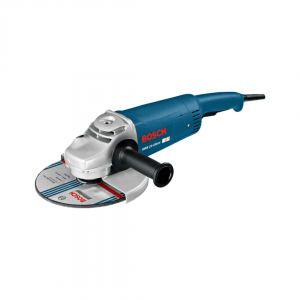How to Use an Angle Grinder
Angle grinders are versatile tools that can grind metal and cut tile, stucco and pavers, rout out mortar, plus they can sand, polish and sharpen.Learn to use an angle grinder to cut tile, mortar and pavers; make quick work of rust and loose paint removal; sharpen blades and cut or grind steel.
You’ll find angle grinders anywhere power tools are sold. Larger hand grinders are available, but the popular 4-in. and 4-1/2 in. grinders are the right size for most tasks. You can buy very inexpensive angle grinder tool, but for frequent use or for demanding jobs like cutting stucco or cement, I’d recommend spending a little more for a grinder with a more powerful motor (look for a motor that draws 5 to 9 amps).
The ability to handle different wheels and accessories is what makes angle grinders so versatile. Your angle grinder includes a spindle washer and spindle nut that you’ll install in different configurations to accommodate thicker or thinner wheels or remove altogether when you screw wire wheels and cups onto the threaded spindle. Consult your manual for instructions on mounting wheels and accessories.
You’ll find abrasive wheels for an angular grinder in any hardware store or home center. Although the wheels all look similar, they’re designed for different tasks. Read the labels.
Metal cleaning
Use a wire brush for cleaning
Wire wheels remove rust and flaking paint quickly. Wire wheel and brush angle grinder attachments are designed for different types of stripping, cleaning and deburring tasks. Wire cup brushes work best for stripping paint or rust from broad, flat areas. Wire wheels fit into crevices and corners more easily. Wheel and brush attachments come in a wide variety of styles. Read the packaging to find one that works for your application. Also, make sure to match the threads to the spindle threads on your grinder. Most angle grinders have 5/8-in. spindle threads, but there are a few oddballs.
Cut bars, rods and bolts
If you’re patient, you can cut most metal with a hacksaw. But for quick, rough cuts, it’s hard to beat a grinder. I’ve used an angle grinder to cut rebar (Photo 3), angle iron, rusted bolts (Photo 4) and welded wire fencing. Use an inexpensive cutoff wheel for these and other metal-cutting tasks.
Cut tile, stone and concrete
Restore cutting edges
Outfitted with a grinding wheel, an angle grinder is a great tool for restoring edges on rough-and-tumble tools like hoes, shovels and ice scrapers or for the initial grinding of axes, hatchets and lawn mower blades. If you need a sharper edge than the grinder leaves, follow up with a mill bastard file. Photo 7 shows how to sharpen a lawn mower blade. Use the same technique to restore the edge on other tools. Orient the grinder so that the wheel spins from the body of the blade toward the edge (refer to the arrow on the body of the grinder to determine which direction the wheel spins).
Finally, with the grinder off, rest the grinding wheel against the blade and adjust the angle of the grinder to match the blade’s bevel. This is the position you’ll want to maintain as you grind the edge. Lift the grinder from the edge, switch it on and let it come to speed before moving it into the blade.
Stroke the grinder across the work in the direction of the handle rather than grinding back and forth. Then lift it off and repeat, concentrating on holding the grinder at a consistent angle throughout the stroke.
It’s easy to overheat a metal blade with a grinder. Overheated metal turns a bluish black or straw color and won’t stay sharp for long. To avoid overheating, apply only light pressure and keep the grinder moving. Also, keep a bucket of water and sponge or rag handy and drench the metal frequently to keep it cool.
Cutting out old mortar
Grind mortar
Grinding beats a chisel and a hammer for removing old mortar. It would be worth buying a grinder just to remove mortar if you had a lot of tuckpointing to do. Thicker diamond tuckpointing wheels remove old mortar quickly without disturbing or damaging the bricks. It’s dusty, though, so wear a dust mask and make sure to shut your windows and warn the neighbors.
We’ve only touched on the jobs you can do with an angle grinder. Browse your local hardware store or home center to get a better idea of the angle grinder attachments available. They can save you a ton of time.
Grinder Safety
Unlike drill motors that run at about 700 to 1,200 rpm, grinders spin at a breakneck speed of 10,000 to 11,000 rpm. They’re fast enough to be scary! Follow these precautions for safe grinder use:
- Wear a face shield and gloves.
- Unplug the grinder when you’re changing wheels.
- Attach the handle and maintain a firm grip with both hands.
- Use the guard if possible.
- Run new wheels for one minute in a protected area before using them to make sure the wheel isn’t defective.
- Orient the work so debris is directed downward.
- Keep bystanders away. Everyone in the vicinity should wear safety glasses.
- Orient the work so the wheel spins away from, not into, sharp edges. Wheels, especially wire wheels, can catch on an edge and throw the workpiece or cause the grinder to kick back (Photo 1).
- Keep sparks away from flammable materials.
- Clamp or secure the workpiece in some fashion.
- Store angle grinders out of children’s reach.






















